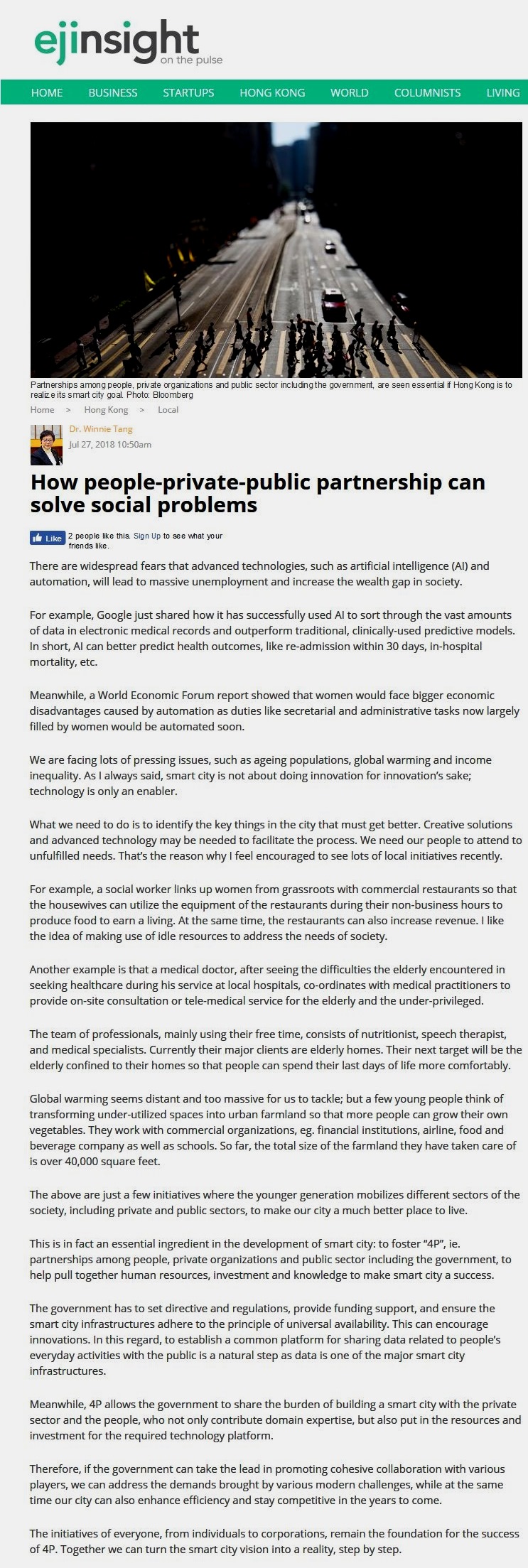網上版請按此

How people-private-public partnership can solve social problems
There are widespread fears that advanced technologies, such as artificial intelligence (AI) and automation, will lead to massive unemployment and increase the wealth gap in society.
For example, Google just shared how it has successfully used AI to sort through the vast amounts of data in electronic medical records and outperform traditional, clinically-used predictive models. In short, AI can better predict health outcomes, like re-admission within 30 days, in-hospital mortality, etc.
Meanwhile, a World Economic Forum report showed that women would face bigger economic disadvantages caused by automation as duties like secretarial and administrative tasks now largely filled by women would be automated soon.
We are facing lots of pressing issues, such as ageing populations, global warming and income inequality. As I always said, smart city is not about doing innovation for innovation's sake; technology is only an enabler.
What we need to do is to identify the key things in the city that must get better. Creative solutions and advanced technology may be needed to facilitate the process. We need our people to attend to unfulfilled needs. That's the reason why I feel encouraged to see lots of local initiatives recently.
For example, a social worker links up women from grassroots with commercial restaurants so that the housewives can utilize the equipment of the restaurants during their non-business hours to produce food to earn a living. At the same time, the restaurants can also increase revenue. I like the idea of making use of idle resources to address the needs of society.
Another example is that a medical doctor, after seeing the difficulties the elderly encountered in seeking healthcare during his service at local hospitals, co-ordinates with medical practitioners to provide on-site consultation or tele-medical service for the elderly and the under-privileged.
The team of professionals, mainly using their free time, consists of nutritionist, speech therapist, and medical specialists. Currently their major clients are elderly homes. Their next target will be the elderly confined to their homes so that people can spend their last days of life more comfortably.
Global warming seems distant and too massive for us to tackle; but a few young people think of transforming under-utilized spaces into urban farmland so that more people can grow their own vegetables. They work with commercial organizations, eg. financial institutions, airline, food and beverage company as well as schools. So far, the total size of the farmland they have taken care of is over 40,000 square feet.
The above are just a few initiatives where the younger generation mobilizes different sectors of the society, including private and public sectors, to make our city a much better place to live.
This is in fact an essential ingredient in the development of smart city: to foster "4P", ie. partnerships among people, private organizations and public sector including the government, to help pull together human resources, investment and knowledge to make smart city a success.
The government has to set directive and regulations, provide funding support, and ensure the smart city infrastructures adhere to the principle of universal availability. This can encourage innovations. In this regard, to establish a common platform for sharing data related to people's everyday activities with the public is a natural step as data is one of the major smart city infrastructures.
Meanwhile, 4P allows the government to share the burden of building a smart city with the private sector and the people, who not only contribute domain expertise, but also put in the resources and investment for the required technology platform.
Therefore, if the government can take the lead in promoting cohesive collaboration with various players, we can address the demands brought by various modern challenges, while at the same time our city can also enhance efficiency and stay competitive in the years to come.
The initiatives of everyone, from individuals to corporations, remain the foundation for the success of 4P. Together we can turn the smart city vision into a reality, step by step.
Dr. Winnie Tang
Honorary Professor, Department of Computer Science, The University of Hong Kong